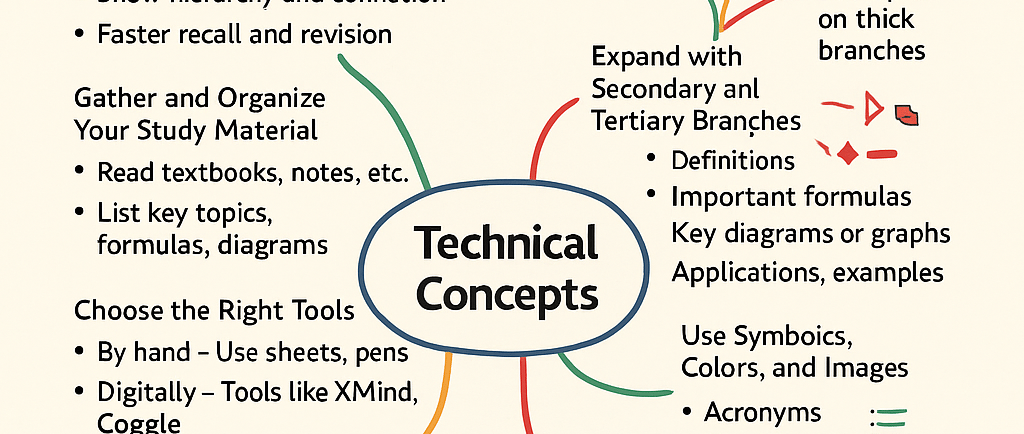How to Prepare Mind Maps for Technical Subjects: A Complete Guide


Mind mapping is a powerful tool that helps students visualize complex information and understand technical subjects better. Whether you’re studying engineering, computer science, physics, or mathematics, a well-structured mind map can turn dense material into a clear, interconnected web of concepts. Here’s how to effectively create mind maps for technical subjects:
1. Understand the Core Purpose of Mind Mapping
Mind maps are visual representations of information that use branching diagrams to show relationships between ideas. They work especially well for technical subjects because they:
Break down complex systems into simpler parts.
Show hierarchy and connection among concepts.
Help in faster recall and revision.
2. Gather and Organise Your Study Material
Before drawing a mind map:
Read your textbook, class notes, and lecture slides thoroughly.
Identify the key topics, subtopics, formulas, and important diagrams.
List out the core concepts you need to understand.
Tip: Use syllabus or unit-wise divisions as your base structure.
3. Choose the Right Tools
You can create mind maps:
By hand – Use blank A4 sheets or notebooks with color pens.
Digitally – Use tools like XMind, MindMeister, Coggle, or Notion.
Digital tools are better for editing and sharing, while handwritten maps boost retention.
4. Start with the Central Concept
Place the main topic (e.g., “Thermodynamics” or “Data Structures”) in the center. Make it bold and visually distinct.
From the central node, draw thick branches for primary subtopics (e.g., “Laws of Thermodynamics,” “Stacks & Queues”).
5. Expand with Secondary and Tertiary Branches
Each primary subtopic should branch into:
Definitions
Important formulas
Key diagrams or graphs
Applications
Examples
Example: For “Second Law of Thermodynamics,” you may branch into:
Clausius Statement
Kelvin-Planck Statement
Entropy Change Equation
6. Use Symbols, Colors, and Images
Colors differentiate sections (blue for theory, red for formulas, green for applications).
Arrows show cause-effect or step-by-step processes.
Icons/diagrams help in subjects like electronics or mechanics.
This enhances visual memory and makes your mind map more engaging.
7. Incorporate Mnemonics or Shortcuts
Wherever applicable, include:
Acronyms
Short tricks
Pattern recognition
This is particularly useful in subjects like chemistry (e.g., “OIL RIG” in redox) or programming (e.g., Big-O complexities).
8. Keep It Concise
Mind maps should summarise – not repeat full paragraphs.
Use bullet points or keywords.
Avoid writing full derivations but highlight critical steps.
9. Revise and Update
Mind maps are dynamic. As you learn more or correct misunderstandings:
Add new branches.
Reorganize hierarchies.
Insert example problems with brief solutions.
10. Practice Retrieval and Active Use
Try redrawing maps from memory.
Use them to explain concepts to someone else.
Solve numerical problems while referring to maps to strengthen linkages.
Conclusion
Creating mind maps for technical subjects is more than an artistic activity—it’s a smart learning strategy. It trains your brain to see the big picture and the fine details simultaneously. Start small, stay consistent, and your technical subjects will start making a lot more sense visually and conceptually.
